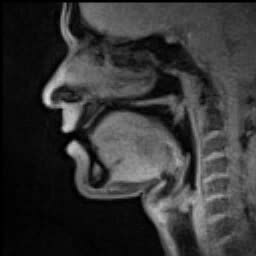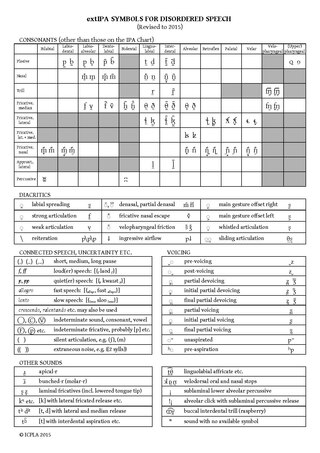Related Research Articles
The following outline is provided as an overview and topical guide to linguistics:
In phonology and linguistics, a phoneme is a unit of phone that can distinguish one word from another in a particular language.
Phonology is the branch of linguistics that studies how languages or dialects systematically organize their phones or, for sign languages, their constituent parts of signs. The term can also refer specifically to the sound or sign system of a particular language variety. At one time, the study of phonology related only to the study of the systems of phonemes in spoken languages, but may now relate to any linguistic analysis either:
A communication disorder is any disorder that affects an individual's ability to comprehend, detect, or apply language and speech to engage in dialogue effectively with others. The delays and disorders can range from simple sound substitution to the inability to understand or use one's native language.
Linguistics is the scientific study of human language. Someone who engages in this study is called a linguist. See also the Outline of linguistics, the List of phonetics topics, the List of linguists, and the List of cognitive science topics. Articles related to linguistics include:
Specific language impairment (SLI) is diagnosed when a child's language does not develop normally and the difficulties cannot be accounted for by generally slow development, physical abnormality of the speech apparatus, autism spectrum disorder, apraxia, acquired brain damage or hearing loss. Twin studies have shown that it is under genetic influence. Although language impairment can result from a single-gene mutation, this is unusual. More commonly SLI results from the combined influence of multiple genetic variants, each of which is found in the general population, as well as environmental influences.
In linguistics, linguistic competence is the system of unconscious knowledge that one knows when they know a language. It is distinguished from linguistic performance, which includes all other factors that allow one to use one's language in practice.
In linguistics, a segment is "any discrete unit that can be identified, either physically or auditorily, in the stream of speech". The term is most used in phonetics and phonology to refer to the smallest elements in a language, and this usage can be synonymous with the term phone.
In linguistics and social sciences, markedness is the state of standing out as nontypical or divergent as opposed to regular or common. In a marked–unmarked relation, one term of an opposition is the broader, dominant one. The dominant default or minimum-effort form is known as unmarked; the other, secondary one is marked. In other words, markedness involves the characterization of a "normal" linguistic unit against one or more of its possible "irregular" forms.

Speech is a human vocal communication using language. Each language uses phonetic combinations of vowel and consonant sounds that form the sound of its words, and using those words in their semantic character as words in the lexicon of a language according to the syntactic constraints that govern lexical words' function in a sentence. In speaking, speakers perform many different intentional speech acts, e.g., informing, declaring, asking, persuading, directing, and can use enunciation, intonation, degrees of loudness, tempo, and other non-representational or paralinguistic aspects of vocalization to convey meaning. In their speech, speakers also unintentionally communicate many aspects of their social position such as sex, age, place of origin, physical states, psychological states, physico-psychological states, education or experience, and the like.

The Extensions to the International Phonetic Alphabet for Disordered Speech, commonly abbreviated extIPA, are a set of letters and diacritics devised by the International Clinical Phonetics and Linguistics Association to augment the International Phonetic Alphabet for the phonetic transcription of disordered speech. Some of the symbols are used for transcribing features of normal speech in IPA transcription, and are accepted as such by the International Phonetic Association.
Language disorders or language impairments are disorders that involve the processing of linguistic information. Problems that may be experienced can involve grammar, semantics (meaning), or other aspects of language. These problems may be receptive, expressive, or a combination of both. Examples include specific language impairment, better defined as developmental language disorder, or DLD, and aphasia, among others. Language disorders can affect both spoken and written language, and can also affect sign language; typically, all forms of language will be impaired.
Speech perception is the process by which the sounds of language are heard, interpreted, and understood. The study of speech perception is closely linked to the fields of phonology and phonetics in linguistics and cognitive psychology and perception in psychology. Research in speech perception seeks to understand how human listeners recognize speech sounds and use this information to understand spoken language. Speech perception research has applications in building computer systems that can recognize speech, in improving speech recognition for hearing- and language-impaired listeners, and in foreign-language teaching.

Speech-language pathology is a healthcare field of expertise practiced globally. Speech-language pathology (SLP) specializes in the evaluation, diagnosis, treatment, and prevention of communication disorders, cognitive-communication disorders, voice disorders, and swallowing disorder across the lifespan. It is an independent profession that is sometimes considered a "related health profession" or allied health profession by professional bodies like the American Speech-Language-Hearing Association (ASHA) and Speech Pathology Australia. Allied health professions include audiology, optometry, occupational therapy, rehabilitation psychology, physical therapy and others.
Lise Menn is an American linguist who specializes in psycholinguistics, including the study of language acquisition and aphasia.
Linguistics is the scientific study of language. It entails the comprehensive, systematic, objective, and precise analysis of all aspects of language — cognitive, social, environmental, biological as well as structural.
Speech and language impairment are basic categories that might be drawn in issues of communication involve hearing, speech, language, and fluency.
Sara Howard is a British speech therapist and Professor Emerita of Clinical Phonetics at the University of Sheffield.
Social (pragmatic) communication disorder (SPCD), also known as pragmatic language impairment (PLI), is a neurodevelopmental disorder characterized by significant difficulties in the social use of verbal and nonverbal communication. Individuals with SPCD struggle to effectively engage in social interactions, interpret social cues, and use language appropriately in social contexts. This disorder can have a profound impact on an individual's ability to establish and maintain relationships, navigate social situations, and participate in academic and professional settings. Although SPCD shares similarities with other communication disorders, such as autism spectrum disorder (ASD), it is recognized as a distinct diagnostic category with its own set of diagnostic criteria and features.
Yiya Chen is a linguist and phonetician specializing in speech prosody. She is professor of phonetics at Leiden University as well as senior researcher at the Leiden Institute for Brain and Cognition.
References
- ↑ Crystal, David (2013-04-01). "Clinical linguistics: Conversational reflections". Clinical Linguistics & Phonetics. 27 (4): 236–243. doi:10.3109/02699206.2012.726312. ISSN 0269-9206. PMID 23339337. S2CID 29314498.
- 1 2 3 4 5 6 7 8 Crystal, David (1981). Arnold, G.E; Winckel, F.; Wyke, B.D (eds.). "Clinical Linguistics". Disorders of Human Communications. 3. doi:10.1007/978-3-7091-4001-7_1.
- 1 2 3 Perkins, M. (2011). "Clinical linguistics: Its past, present and future". Clinical Linguistics & Phonetics. 25 (11-12) (Nov-Dec 2011): 922–927. doi:10.3109/02699206.2011.599471. PMID 21787145. S2CID 44942567 . Retrieved 10 April 2019.
- ↑ Jakobson, Robert (1941). Kindersprache, aphasie und allgemeine lautgesetze. Uppsala, Sweden: Almqvist and Wiksell.
- ↑ Jakobson, Robert (1968). Child language, aphasia and phonological universals. The Hague: Mouton.
- ↑ Ingram, D (1976). Phonological disability in children. New York: Elsevier.
- ↑ Grunwell, P (1982). Clinical phonology. London: Croom Helm.
- ↑ Crystal, D; Fletcher, P; Garman, M (1982). Grammatical analysis of language disability. London: Arnold.
- ↑ Crystal, D (1982). Profiling linguistic disability. London: Arnold.
- ↑ Neurath, O; Carnap, R; Morris, Charles F.W., eds. (1955). "International Encyclopedia of Unified Science". Chicago, IL: University of Chicago Press.
{{cite journal}}: Cite journal requires|journal=(help) - ↑ Perkins, Michael (2007). Pragmatic Impairment. Cambridge University Press: Cambridge University Press. pp. 8–30. ISBN 978-0-521-79070-3.
- ↑ Cummings, L. (2017). "Clinical linguistics". Oxford Research Encyclopedia of Linguistics. New York: Oxford University Press. doi:10.1093/acrefore/9780199384655.013.337. ISBN 978-0-19-938465-5.
- ↑ "SLP Resource Guide: Standardized Assessment Resource List". Indiana Institute on Disability and Community. Indiana University, Bloomington. n.d. Retrieved 11 April 2019.